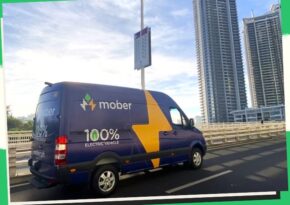
Driving Change: Capturing Semi-Truck CO2 Emissions for a Greener Future
Explore the groundbreaking technology capturing CO2 emissions from semi-trucks, paving the way for cleaner highways and a healthier planet.
Driving Towards Sustainability: A Guide to Capturing Semi-Truck CO2 Emissions 

As the backbone of global logistics, semi-trucks play a crucial role in transporting goods across vast distances. However, their reliance on fossil fuels contributes significantly to carbon dioxide (CO2) emissions, exacerbating climate change. To address this environmental challenge, innovative technologies for capturing and reducing CO2 emissions from semi-trucks are gaining traction. In this guide, we’ll explore the basics of capturing semi-truck CO2 emissions and provide practical tips for embracing sustainable transportation solutions.
Understanding CO2 Emissions from Semi-Trucks
Semi-trucks, also known as tractor-trailers or articulated lorries, are powered by diesel engines that combust fuel to generate the necessary energy for propulsion. As a byproduct of this combustion process, CO2 and other greenhouse gases are emitted into the atmosphere, contributing to global warming and air pollution. Capturing and mitigating these emissions is essential for transitioning towards a more sustainable transportation sector.
Capturing CO2 Emissions: Technologies and Methods
- Exhaust Gas Capture Systems: These systems are designed to capture CO2 emissions directly from the exhaust stream of semi-truck engines. Using specialized filters or chemical absorbents, they isolate CO2 molecules before they are released into the atmosphere.
- Carbon Capture and Storage (CCS): CCS technologies involve capturing CO2 emissions at the source, such as from the exhaust of semi-truck engines, and storing them underground or repurposing them for industrial applications. This prevents CO2 from entering the atmosphere, effectively reducing greenhouse gas emissions.
- Renewable Energy Integration: By incorporating renewable energy sources such as solar or wind power into semi-truck operations, fleet operators can reduce their reliance on fossil fuels and minimize CO2 emissions. Electric semi-trucks powered by clean energy sources offer a promising alternative to traditional diesel vehicles.
Tips for Implementing CO2 Capture Technologies
- Assess Your Fleet: Evaluate the size and composition of your semi-truck fleet, considering factors such as mileage, fuel consumption, and emissions profiles to determine the most suitable CO2 capture technologies.
- Research Available Solutions: Explore the various CO2 capture technologies and methods available in the market, taking into account factors such as efficiency, scalability, and compatibility with existing infrastructure.
- Collaborate with Suppliers: Engage with technology providers and suppliers specializing in CO2 capture solutions to develop a customized plan tailored to your fleet’s needs and operational requirements.
- Pilot Test Programs: Implement pilot test programs to evaluate the performance and feasibility of CO2 capture technologies in real-world conditions, gathering data to inform future deployment strategies.
- Train Personnel: Provide training for drivers and maintenance staff on the operation and maintenance of CO2 capture systems, ensuring proper implementation and optimal performance.
- Monitor and Optimize: Utilize data analytics and monitoring tools to track CO2 emissions, identify opportunities for optimization, and maximize the effectiveness of CO2 capture technologies.
Challenges and Future Outlook
While capturing CO2 emissions from semi-trucks holds immense promise for mitigating climate change and promoting sustainable transportation, several challenges remain, including technological barriers, cost considerations, and regulatory complexities. However, with continued research and innovation, coupled with supportive policies and incentives, the future of CO2 capture technologies appears promising. By embracing these solutions, stakeholders can drive meaningful progress towards a greener, more sustainable future for the transportation industry.
Benefits of Capturing Semi-Truck CO2 Emissions
- Emission Reduction: Capturing CO2 emissions from semi-trucks helps mitigate their environmental impact, reducing greenhouse gas emissions and combating climate change.
- Air Quality Improvement: By capturing CO2 emissions, semi-trucks contribute to improving local air quality, reducing pollution-related health risks in urban and industrial areas.
- Climate Mitigation: The capture of CO2 emissions from semi-trucks contributes to global efforts to mitigate climate change by curbing the release of harmful greenhouse gases into the atmosphere.
- Renewable Energy Production: Captured CO2 emissions can be repurposed for use in renewable energy production processes such as biofuel generation, contributing to a more sustainable energy ecosystem.
- Technological Innovation: Developing and implementing CO2 capture technologies for semi-trucks drives innovation in the transportation sector, fostering the advancement of cleaner and more efficient vehicles.
- Regulatory Compliance: Capturing CO2 emissions helps semi-truck operators comply with increasingly stringent environmental regulations and emissions standards imposed by governments and regulatory bodies.
- Cost Savings: While initial investment costs may be significant, capturing CO2 emissions can result in long-term cost savings through reduced fuel consumption and operational efficiencies.
- Corporate Social Responsibility: Embracing CO2 capture technologies demonstrates a commitment to corporate social responsibility and sustainability, enhancing the reputation of companies in the transportation industry.
- Health Benefits: By reducing CO2 emissions, capturing technologies contribute to improved public health outcomes by minimizing exposure to air pollutants associated with respiratory and cardiovascular diseases.
- Transition to Low-Carbon Economy: Capturing CO2 emissions from semi-trucks accelerates the transition to a low-carbon economy, aligning with global sustainability goals and initiatives.
Case Studies
- Carbon Capture Retrofit: The deployment of carbon capture retrofit technologies on semi-trucks by companies like Carbon Clean Solutions and Climeworks demonstrates the feasibility of capturing CO2 emissions directly from vehicle exhaust systems.
- Hydrogen Fuel Cells: Companies like Nikola Corporation are developing hydrogen fuel cell-powered semi-trucks equipped with carbon capture and utilization systems, offering a zero-emission solution for freight transportation.
- Direct Air Capture: Projects such as the Climeworks’ collaboration with Swiss Post and the South Pole demonstrate the use of direct air capture technology to capture CO2 emissions from semi-truck fleets, paving the way for scalable carbon removal solutions.
- Biofuel Production: Companies like ExxonMobil are investing in research and development initiatives to produce biofuels from captured CO2 emissions, providing a sustainable alternative to traditional fossil fuels for semi-truck fleets.
- Carbon Offsetting: Initiatives such as the Shell Fleet Solutions program enable semi-truck operators to offset their CO2 emissions by investing in carbon capture and storage projects, fostering collaboration between industry stakeholders to address climate change.
- Carbon Utilization: Companies like Carbon Engineering are exploring innovative carbon utilization pathways, such as converting captured CO2 emissions into valuable products like synthetic fuels and building materials, creating new revenue streams and reducing environmental impact.
- Partnerships for Sustainability: Collaborative efforts between technology providers, fleet operators, and government agencies, such as the DOE’s Carbon Capture, Utilization, and Storage R&D program, drive the development and deployment of carbon capture technologies for semi-trucks.
- Policy Support: Governments worldwide are implementing policies and incentives to encourage the adoption of carbon capture technologies in the transportation sector, including grants, tax credits, and emissions trading schemes.
- Public-Private Partnerships: Public-private partnerships, such as the Carbon Capture Coalition and the Global CCS Institute, facilitate knowledge sharing, research collaboration, and investment in carbon capture infrastructure for semi-trucks.
- International Collaboration: Multinational initiatives like the Paris Agreement and the Carbon Neutrality Coalition promote international cooperation to address climate change and accelerate the deployment of carbon capture solutions for semi-trucks on a global scale.
Key Takeaways
- Climate Imperative: Capturing CO2 emissions from semi-trucks is essential for mitigating climate change and achieving global emissions reduction targets.
- Technological Progress: Advances in carbon capture and utilization technologies are driving innovation in the transportation sector, enabling the development of cleaner and more sustainable vehicles.
- Collaborative Efforts: Public-private partnerships and international collaboration are crucial for overcoming technical, regulatory, and financial barriers to the widespread adoption of carbon capture solutions for semi-trucks.
- Policy Alignment: Supportive policies and incentives play a vital role in incentivizing investment in carbon capture technologies and promoting the transition to low-carbon transportation.
- Market Opportunities: The growing demand for carbon capture solutions presents significant market opportunities for technology developers, fleet operators, and investors in the transportation industry.
- Resource Efficiency: Capturing CO2 emissions from semi-trucks enables the efficient utilization of carbon resources, contributing to circular economy principles and sustainable resource management.
- Adaptation and Resilience: Carbon capture technologies enhance the resilience of semi-truck fleets to climate-related risks and regulatory changes, ensuring continued viability and competitiveness in a carbon-constrained world.
- Stakeholder Engagement: Engaging stakeholders across the value chain, including manufacturers, regulators, investors, and consumers, is essential for driving adoption and scaling up carbon capture solutions for semi-trucks.
- Continuous Improvement: Continuous research and development efforts are necessary to improve the efficiency, scalability, and cost-effectiveness of carbon capture technologies for semi-trucks.
- Global Impact: Capturing CO2 emissions from semi-trucks has far-reaching environmental, economic, and social benefits, contributing to sustainable development and a healthier planet for future generations.
FAQs (Frequently Asked Questions)
- Q: How does carbon capture technology work for semi-trucks?
A: Carbon capture technologies capture CO2 emissions directly from the exhaust systems of semi-trucks using chemical absorption, adsorption, or membrane separation processes. - Q: What are the main challenges associated with capturing CO2 emissions from semi-trucks?
A: Challenges include technological complexity, cost competitiveness, scalability, and regulatory uncertainty, which require concerted efforts from industry stakeholders to overcome. - Q: What are the potential risks and drawbacks of carbon capture technologies for semi-trucks?
A: Risks include energy consumption, environmental impacts of capture materials, and potential leakage of captured CO2, which must be addressed through rigorous risk assessment and mitigation measures. - Q: Are there any alternatives to carbon capture for reducing CO2 emissions from semi-trucks?
A: Alternatives include fuel efficiency improvements, electrification, alternative fuels such as hydrogen and biofuels, and modal shifts to rail and waterway transportation for certain freight routes. - Q: How do carbon capture technologies for semi-trucks contribute to sustainable development goals?
A: Carbon capture technologies support multiple sustainable development goals, including climate action, affordable and clean energy, industry innovation, and sustainable cities and communities. - Q: What is the cost-effectiveness of capturing CO2 emissions from semi-trucks compared to other mitigation strategies?
A: The cost-effectiveness varies depending on factors such as technology maturity, regulatory environment, fuel prices, and carbon pricing mechanisms, with carbon capture becoming increasingly competitive as costs decline and policies incentivize emissions reductions. - Q: How do carbon capture technologies for semi-trucks impact vehicle performance and operational efficiency?
A: Carbon capture technologies may impose energy and weight penalties on semi-trucks, affecting vehicle performance and operational efficiency, necessitating trade-offs and optimization strategies to minimize impacts. - Q: What role do governments and regulatory bodies play in promoting the adoption of carbon capture technologies for semi-trucks?
A: Governments and regulatory bodies provide financial incentives, research funding, emissions standards, and carbon pricing mechanisms to incentivize investment in carbon capture technologies and accelerate their deployment in the transportation sector. - Q: Are there any emerging trends or developments in carbon capture technologies for semi-trucks?
A: Emerging trends include the integration of carbon capture with hydrogen fuel cells, advancements in direct air capture and utilization, and novel materials and processes for capturing CO2 more efficiently and cost-effectively. - Q: How can stakeholders collaborate to overcome barriers and accelerate the adoption of carbon capture technologies for semi-trucks?
A: Stakeholders can collaborate through research consortia, industry associations, public-private partnerships, and knowledge-sharing platforms to address technical, regulatory, and financial challenges and drive innovation and adoption of carbon capture solutions for semi-trucks.
Conclusion
As the demand for goods transportation continues to grow, the need for sustainable solutions to mitigate the environmental impact of semi-trucks has never been more urgent. By capturing and reducing CO2 emissions from these vehicles, we can drive positive change towards a more sustainable transportation sector, protecting the planet for future generations. Let’s accelerate the adoption of CO2 capture technologies and drive towards a greener, cleaner future for all.
Key Phrases
- Semi-Truck CO2 emissions capture
- Freight transport sustainability
- Green logistics solutions
- Climate-friendly freight transport
- Carbon capture technology
- Road transportation emissions reduction
- Sustainable freight transport
- CO2 emission mitigation
- Clean highway initiatives
- Environmental responsibility in logistics
Best Hashtags
- #TruckCO2Capture
- #GreenFreight
- #SustainableTransport
- #ClimateFriendlyLogistics
- #CarbonCaptureTechnology
- #CleanHighways
- #EcoFriendlyFreight
- #GreenLogistics
- #CO2Mitigation
- #SemiTruckEmissions
Save/Share this story with QR CODE
Disclaimer
This article is for informational purposes only and does not constitute endorsement of any specific technologies or methodologies and financial advice or endorsement of any specific products or services.
 Need to get in touch?
Need to get in touch?

We appreciate your reading. 
1.) 

Your DONATION will be used to fund and maintain NEXTGENDAY.com
Subscribers in the Philippines can make donations to mobile number 0917 906 3081, thru GCash.
3.) 
4.) 
AFFILIATE PARTNERS

World Class Nutritional Supplements - Buy Highest Quality Products, Purest Most Healthy Ingredients, Direct to your Door! Up to 90% OFF.
Join LiveGood Today - A company created to satisfy the world's most demanding leaders and entrepreneurs, with the best compensation plan today.

 Business, Finance & Technology
Business, Finance & Technology





